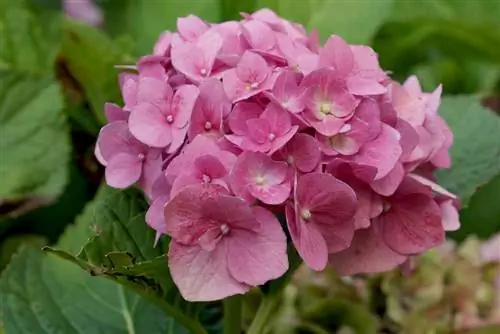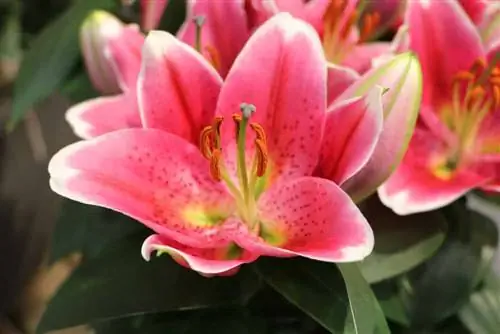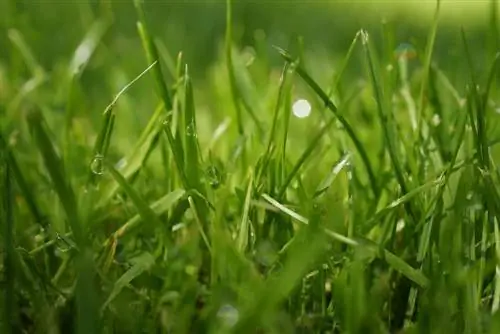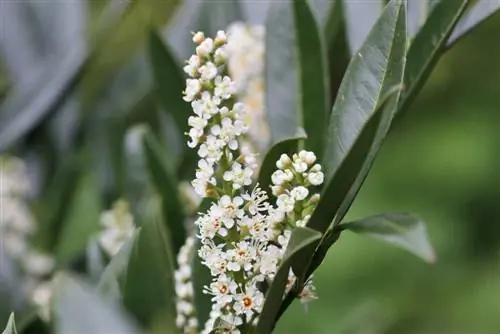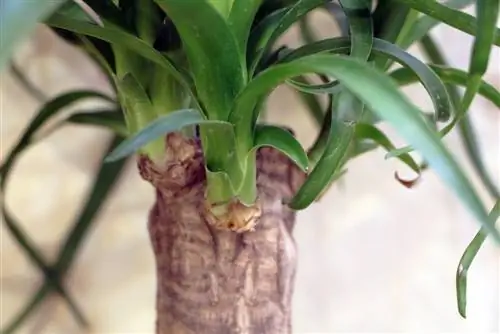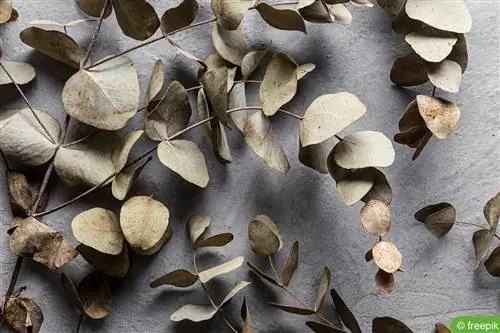- Author admin [email protected].
- Public 2023-12-17 03:39.
- Last modified 2025-06-01 06:48.
As woody shrubs, farmer's hydrangeas and hydrangeas wage a silent battle against bitter frost in winter. Especially modern hydrangea varieties with huge flowers in furious color nuances often pay for their magnificent beauty with reduced winter hardiness. While hydrangeas in beds survive the winter unscathed in regions with mild winters, the flowering bushes in pots rely on supportive measures. This green guide deals in detail with competent overwintering of hydrangeas in pots and provides well-founded tips for the best care during the cold season.
Subshrubs and winter time - a double-edged sword
The classic hydrangeas for beds and balconies thrive as shrubs or small standard stems. Since they form their buds on the woody branches of the previous year, they are considered difficult to cut. The ornamental trees make up for this fact with their reliable winter hardiness, which requires light protection, especially in harsh regions. Modern breeds avoid this growth behavior.
Innovative hydrangea lines such as Endless Summer or Everbloom bloom on both this year's and last year's shoots. The feat is successful because they are bred as sub-shrubs with a woody base and herbaceous to semi-woody shoots. Since the focus here was on lavish blooms and uncompromising cut compatibility, modern varieties have less to withstand frosty temperatures.
In the harsh winter, the shoots freeze back partially or completely. If a stable, well-wooded cane has not yet developed when young, the flowering bushes are at risk of dying. The good pruning tolerance then comes to nothing because there are no longer any sleeping eyes from which new shoots could develop. This danger is significantly greater in the pot, as the root ball is in a vulnerable, exposed position. With the right protective precautions and expert care, hydrangeas can overwinter unscathed.
Overwintering in a pot - this is how it works
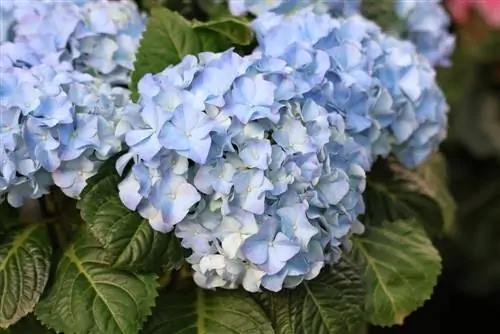
Hydrangeas in pots can overwinter outside as long as the container has a diameter of at least 30 cm. With a combination of sufficient substrate volume and the following protective measures, there is a good chance that the flowering trees will get through the cold season he althy and happy:
- Do not fertilize from August onwards so that the branches mature before the first frost
- Before the onset of winter, move the pot to a shady location protected from wind and rain
- Push a thick wooden or polystyrene plate between the substrate and the bottom of the pot
- Wrap the bucket with several layers of bubble wrap
- Cover the substrate with autumn leaves, wood shavings or bark mulch
Finally, the pot is given a winter coat made of insulating coconut. To do this, cover the container with a coconut mat that extends over the edge of the pot by at least 10 cm. Please do not cut off the withered flower heads under any circumstances. Throughout the winter they act like a small bulwark against frost and snow for the already established buds and sleeping eyes. In addition, a cut always encourages fresh shoots, which weakens the hydrangeas considerably just before winter.
Tip:
Pot hydrangeas only receive their winter protection when the temperatures fall below freezing. As the ornamental shrubs follow the gradual change from autumn to winter climate, the immune system is naturally strengthened.
Putting away small pots - tips for winter quarters
Pots with a diameter of less than 30 cm do not provide the root ball of a hydrangea with sufficient substrate volume for overwintering outdoors. There is too great a risk that the root strands will freeze. By putting the bucket in an adequate winter quarters, you avoid the risk of frost damage. There are various options available for wintering behind glass:
- In a bright, unheated winter garden or greenhouse with shading to protect against sunlight
- In the dark, cool basement at temperatures of 3-5 degrees Celsius
A place in bright, warm living rooms is theoretically also possible. This alternative, however, is considered an emergency solution. Under the influence of dry heating, your hydrangeas are an easy victim for scale insects and spider mites. In addition, there is no winter dormancy in growth, which is desirable for vital flower induction.
Overwintering tent solves space problems
Is there no suitable space available indoors or outdoors for overwintering potted hydrangeas? Then you don't have to expose the flower beauties to the rigors of the cold season without protection. With a winter tent you can offer your ornamental trees a frost-repellent and storm-stable retreat. Hobby gardeners who want to save themselves and their hydrangeas the stress of putting things away also like to use this solution. The concept was copied from mobile orangeries for citrus plants and scaled down to the requirements of hydrangeas.
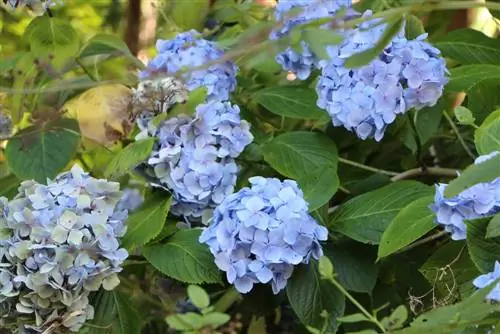
A high-quality winter tent consists of translucent and UV-resistant film and a cold-insulating floor. A large zipper allows access with the watering can. One or two window openings allow a regular supply of fresh air when it is not freezing. Guy ropes and a sturdy tube pole protect the tent from storm damage. Since there is no need for heating, the costs for an outdoor winter quarters with a diameter of 130 cm and a height of 220 cm are around 230 euros.
Tip:
Panicle hydrangeas have unsurpassed winter hardiness among the hydrangea species. The strong-growing shrubs are assigned to winter hardiness zone Z3, which means they are resistant to frost down to -34.4 degrees Celsius. This at least applies to planted panicle hydrangeas. Hydrangea paniculata in pots can overwinter outside with light winter protection.
Care instructions for the winter
The care program for the perfect wintering of hydrangeas begins in late summer. The last nutrient supply in autumn should consist of a fertilizer with a high potassium content. Potassium strengthens the winter hardiness of frost-sensitive ornamental plants because, among other things, the nutrient lowers the freezing point in the cell water. Since hydrangeas react sensitively to high s alt concentrations, high-quality potassium magnesia is preferable to inexpensive potassium chloride. Kalimagnesia is known under the product name Patentkali. The autumn fertilizer supplies the flowering bushes with natural potassium as well as magnesium and sulfur. In the ecologically managed ornamental garden, you can cover the autumn nutrient needs of your hydrangeas with organic comfrey manure, which is also rich in potassium.
From mid-August, hydrangeas are no longer fertilized so that the flowering plants gradually stop growing and mature. The care is now modified to take into account the requirements of the winter time. How to do it right:
- Do not apply fertilizer from September to March
- Successively reduce the amount of irrigation water
- From November onwards, water only little by little so that the root ball does not dry out
- Check the plants regularly for pests in the warm winter quarters
If hydrangeas continue to receive as much water in early autumn as in summer, bud formation will be inhibited. Therefore, the winter care program includes the recommended reduction. However, a root ball should not dry out at any time. In the winter quarters behind glass and in the rain-protected location in the open air, please water whenever the finger test shows that the soil has dried to a depth of 2 to 3 cm.
If in spring the temperatures regularly remain above freezing even at night, the winter protection can be removed or the pot cleared out. You can use a minimum-maximum thermometer to determine the right date. If you have planned a sunny location for your hydrangeas, the plants should first acclimatize in partial shade for 10 to 14 days. If the leaves are exposed to the sun's rays unprepared, leaf damage due to sunburn is inevitable.
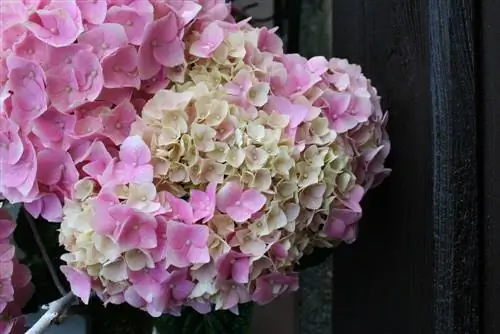
If your hydrangeas freeze back severely during a harsh winter, this is no cause for concern. If the bushes in the pot have received winter protection according to these instructions, they will happily sprout again from the undamaged bush. Please cut all frozen shoots back to he althy wood. He althy wood can be recognized by the fact that there is green tissue under the bark.
Frost protection for buds in spring
Delayed ground frosts represent the greatest potential for damage to hydrangeas. In wintery regions, even after the Ice Saints in mid-May, the temperatures can drop so low at night that the tender buds freeze. So keep an eye on the weather forecast until after the sheep cold in mid-June. If the meteorologists announce ground frost, cover the branches with a breathable, translucent fleece overnight. The hood is removed during the day to prevent condensation from forming, which promotes mold and fungal spores. These precautions are recommended for hydrangeas in pots and beds alike.
Conclusion
The winter makes life difficult for the most beautiful new generation hydrangeas in harsh locations when they are grown in pots. With these instructions you have a practical strategy at hand to successfully overwinter your valuable flowering bushes. In a shady, rain- and wind-protected location in front of a house wall, a winter coat made of foil and coconut mats keeps the frost at a distance from the root ball. Small pots with a diameter of less than 30 cm are ideally moved to a bright, frost-free winter quarters. If an autumn fertilizer with potassium in August has increased frost hardiness, the care program is reduced to occasional watering so that the soil does not dry out. Under these conditions, even the most cold-sensitive hydrangeas in pots emerge victorious in the silent battle against frost.

